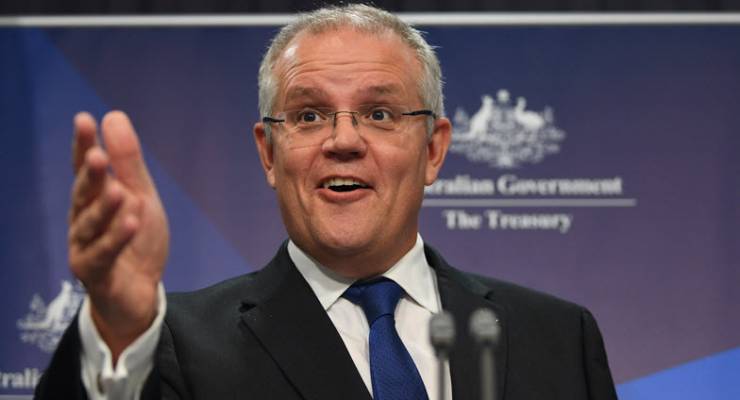
With the Wage Price Index numbers for the June quarter we received a month ago, Treasury racked up an unfortunate record: for the fifth straight year, it had badly overestimated wage growth in its budget forecasts — one important reason why it has regularly overestimated tax revenue under successive governments. At the 2016 budget, Treasury (and the Treasurer, who selects from Treasury’s offered range of scenarios in planning the budget) forecast WPI growth for the year at 2.5%; in the Mid Year Economic and Fiscal Outlook, the forecast was revised down to 2.25%. In the end, that was still too optimistic. The June quarter confirmed what the two previous quarters had shown: WPI growth was stuck at 1.9%.
It’s been the same story going back to 2012. In 2015, the budget prediction was 2.5%; the final result was 2.1%. In 2014, 3% wage growth was expected but it only reached 2.3%. In 2013, 3.25% versus 2.5%; in 2012; 3.75% versus 2.9%. The 2011 budget was the last time Treasury got it right: the budget predicted 4% growth; MYEFO revised that down to 3.75%, the result was 3.7%.
Continuing the optimism, the 2017 budget forecasts 2.5% WPI growth for the current financial year. That will require WPI, which has been stubbornly steady at 0.5% per quarter since October last year, to rise to 0.6% every quarter. It might not seem much, and Australian workers will be hoping it turns out to be correct, but it would require a big turnaround in Treasury’s forecasting fortunes.
[Non-debate over productivity turns to attacking Treasury]
Treasury has also struggled, more famously, with nominal GDP growth, another key contributor to revenue forecasts. After being about on the money, so to speak, in 2010 and near enough in 2011, Treasury badly overestimated nominal growth in 2012 — 5% forecast in the budget, 4% forecast in MYEFO, and a 2.5% result. There was a better result in 2013: 3.75% was the budget forecast and it was revised down in MYEFO but ended up being 4%. Since then, nominal growth has undershot: 3% in the 2014 budget against a 1.6% result; 3.25% in 2015 against a 2.3% result. Will 2016 break the drought? Last year’s MYEFO significantly revised nominal growth upward from 4.25% to 5.75%; the June quarter GDP result due in coming weeks will tell us how Treasury has fared.
Treasury is also poor at predicting change to our terms of trade, but 1. that’s more understandable given the complexity of that forecast and 2. it goes both ways. From 2011-15, terms of trade forecasts were routinely more optimistic than what transpired as commodity prices fell further than expected. The 2016 forecast of 1.25%, however, now looks wildly pessimistic — it was revised up to 14% in MYEFO and in the March quarter national accounts annual terms of trade growth was nearly 25% seasonally adjusted, meaning it will take a substantial fall in the final quarter of 2016-17 not to exceed forecasts.
[RBA offers a reality check on economic forecasting]
Business investment has also proven difficult to predict: the 7% fall predicted in the 2015 budget became a 9.5% fall in MYEFO and a 10.3% fall across the year. In 2014, Treasury almost scored a bullseye with its -5.5% forecast (-6.2%, as it turned out) but in 2013 the forecast 1.5% rise became a 5.1% fall; 12.5% in 2012 became 6.1%, but 2011’s 16% was swamped by extra mining investment to reach nearly 21%. But Treasury has been much better at picking dwelling investment — it’s been both more accurate and, when it’s wrong, wrong on the downside: 2015’s forecast of 6.5% became a building boom of 10.6%; 2012, 2013 and 2014 were all within 0.4 percentage points of the budget forecast; 2016’s 2% forecast again looks on the low side.
And unemployment forecasts have also performed well: all but one of the budget forecasts since 2010 have come in less than 10% off, the exception being 2015 when the budget prediction of 6.5% turned out to be much too pessimistic, the result being 5.7%. But you can bet successive treasurers would have gladly swapped that accuracy for getting WPI and nominal GDP right much more often.








Crikey is committed to hosting lively discussions. Help us keep the conversation useful, interesting and welcoming. We aim to publish comments quickly in the interest of promoting robust conversation, but we’re a small team and we deploy filters to protect against legal risk. Occasionally your comment may be held up while we review, but we’re working as fast as we can to keep the conversation rolling.
The Crikey comment section is members-only content. Please subscribe to leave a comment.
The Crikey comment section is members-only content. Please login to leave a comment.